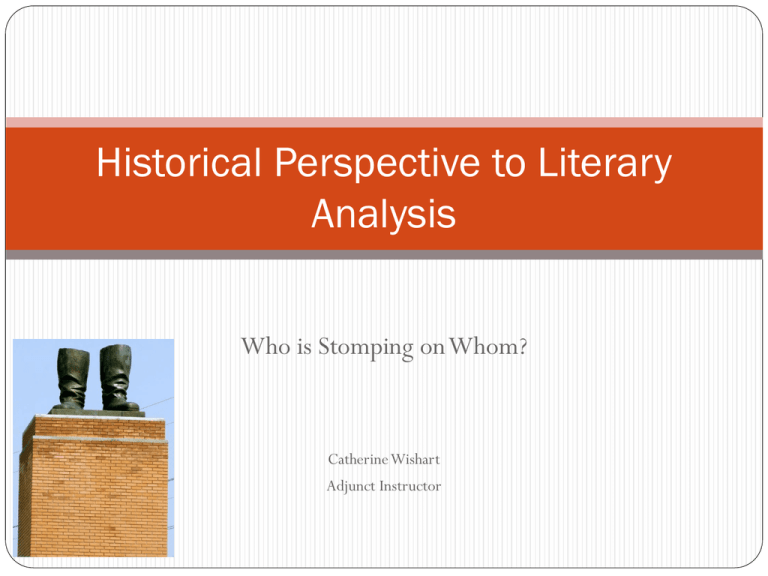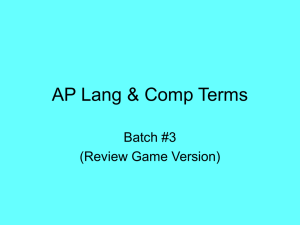Historical Perspective to Literary Analysis
advertisement

Historical Perspective to Literary Analysis Who is Stomping on Whom? Catherine Wishart Adjunct Instructor The Importance of the Historical Perspective Historical novels often make important comments on the human condition in a particular era. Understanding the human condition and social pressures helps understand the work How can we understand Uncle Tom’s Cabin by Harriet Beecher Stowe without background knowledge about slavery? How can we understand The Jungle by Upton Sinclair without understanding the treatment of immigrants in the early 20th century? The conditions in meat packing plants then? (Guerin et al 52). The Concept of Historical Perspective Traditional historical perspective asserts that there “are ‘facts’ that we can know, with some degree of certainty, and as readers we… need to gather them…, and fit them together…, and cautiously relate them to literary works” (Lynn 145). “A historical reading of a literary work begins by exploring the possible ways in which the meaning of the text has changed over time” (Kennedy 1474). Historical Criticism Goals • To strive to understand a literary text as a product of the social, cultural, and intellectual context in which it was created. • To examine how the text was initially received by readers as well as how its reception has changed over time. • To examine how the author’s own experiences may be reflected in the text. Two Ways to Approach Literature from a Historical Perspective – Divergence of Thought Old Historicism looks at the time in which a piece was written to determine how it was interpreted by its contemporaries. New Historicism demonstrates how a literary work reflects ideas and attitudes of the time in which it was written. (DiYanni 1565). Why Examine the Time Period in Which a Piece Was Written? Every literary work is written in a specific time Time periods change how people think Time periods change views of the world Every time period has specific social values Social values influence how a piece is written Social values influence intellectual beliefs Example: Shakespeare Shakespeare wrote in a tumultuous time when some in power believed the theater to be an evil influence Did he write “all the world’s a stage” to comment on these attacks? Kurt Vonnegut wrote Slauterhouse Five during the Viet Nam War Era While the book is about World War II, how much of it is a commentary on the Viet Nam War? Why Demonstrate How a Work Reflects its Time? Many literary works comment on power struggles that are occurring during the time in which they were written Examining other texts of the same time period, such as diaries, records, and institutions helps understand the literary work better Language influences how we interpret text (the diction of a piece) Comparing and contrasting “the language of contemporaneous documents and literary works” reveals “hidden assumptions, biases, and cultural attitudes that relate to the two kinds of texts… demonstrating how the literary work shares the cultural assumptions” of the time (DiYanni 1566). Example: “A Rose for Emily” uses language that is taboo today. A Checklist of Historical and New Historicist Critical Questions 1. 2. 3. 4. 5. 6. 7. When was the work written? When was it published? How was it received by the critics and public? Why? What does the work’s reception reveal about the standards of taste and value during the time period it was published and reviewed? What social attitudes and cultural practices related to the action of the work were prevalent during the time the work was written and published? What kinds of power relations does the work describe, reflect, embody? How do the power relations reflected in the literary work manifest themselves in the cultural practices and social institutions prevalent during the timer the work was written and published? What other types of historical documents, cultural artifacts, or social institutions might be analyzed in conjunction with particular literary works? How might close reading of such nonliterary “text” illuminate those literary works? To what extent can we understand the past as it is reflected in the literary work? To what extent does the work reflect differences from the ideas and values of its time? (Di Yanni 1567). Works Cited DiYanni, Robert. Literature Approaches to Fiction, Poetry, and Drama. Boston: McGraw Hill, 2008. Guerin, Wilfred L., Labor, Earle, Morgan, Lee, Reesman, Jeanne C., Willingham, John R. A Handbook of Critical Approaches to Literature. 5th ed. NY: Oxford U P, 2005. Print.











